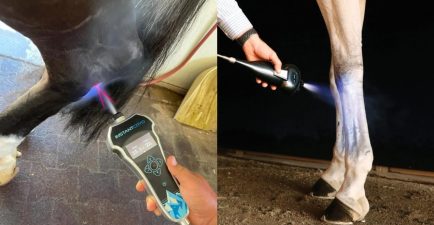From glucose to frustose to lactose–not to mention a laundry list of other “oses”–carbohydrates can be incredibly confusing. But this group of sugar-based compounds, also called saccharides, comprises important energy sources for the horse. Therefore, understanding them and utilizing them in your horse’s diet are crucial. They also are a major component of forages, a staple of the horse’s diet, and are required for digestive health.
The simplest carbohydrates are monosaccharides (made up of one unit and also called simple sugars), such as glucose, fructose, xylose, and galactose. Another type of carbohydrate is a disaccharide (two sugars bonded together), which includes lactose (found commonly in milk, made from a unit of glucose and galactose) and sucrose (table sugar, made from glucose and fructose). Then there are oligosaccharides (three to 200 units each) and polysaccharides, or “complex carbohydrates” (each made up of multiple units, typically 200-2,000, which include compounds such as starch and cellulose). Cellulose is considered a type of dietary fiber, along with hemicellulose, lignin, pectins, and fructans.
How Carbs Work
After a horse consumes the carbohydrates found in forages and grains, the actions of enzymes found primarily in the small intestine break disaccharides and starch into monosaccharides that are then absorbed into the bloodstream, where they are converted for energy or energy storage (more on this in a moment). Dietary fibers, on the other hand, such as cellulose, hemicellulose, and pectins, are not digested by enzymes, but instead undergo fermentation.
Within the cecum and large colon are large populations of microbial organisms that have the ability to break down these complex fibrous carbohydrates into volatile fatty acids that are then absorbed and used as energy sources (calories). However, not all fibers can be fermented effectively, thereby decreasing their overall digestibility; for example, cellulose is typically only 40% digestible, hemicellulose 50% digestible, and lignin is not at all digestible. In contrast, pectins and fructans are believed to be highly fermentable and have higher overall digestibility.
The horse appears to be limited in his ability to digest starch, especially in large amounts. When horses consume too much starch (such as with a high-grain diet or a wayward horse getting into the feed bin), enzymes in the small intestine cannot properly digest it. Undigested starch will, therefore, reach the large intestine and the microbes within it. These microbes might not be accustomed to dealing with large amounts of starch, which could cause a disruption to the microbial ecosystem. This can result in the overproduction of other acids such as lactic acid and/or gas, potentially resulting in colic. Alternatively, it could result in the death of some microbes, causing them to release toxins that can be absorbed by the horse, potentially causing laminitis.
Any glucose produced by the enzyme breakdown in the small intestine is absorbed there and enters the bloodstream, causing an increase in blood glucose concentrations. This increase stimulates the release of the hormone insulin, which functions to move glucose from the blood into the body tissues, thereby bringing blood glucose concentrations back to baseline. Once in the tissues, glucose can be metabolized to produce energy, or it can be converted to fat or glycogen (a polysaccharide of glucose units found in the body) for energy storage. The volatile fatty acids, once absorbed from the cecum and large colon, can also be either metabolized to energy or converted to fat.
Carbohydrates are, therefore, considered important energy sources for the horse. Cereal grains (e.g., corn, oats, or barley) are full of highly digestible carbohydrates such as simple sugars and starch. Forages will have some simple sugars and starches, but they are higher in fiber and therefore provide less digestible energy per unit weight. For example, cereal grains have more than 3 Mcal of energy per kilogram (ranging from 3.2-3.8 Mcal/kg), while hay can range between 1.8-2.4 Mcal/kg, depending on the plant type.
While cereal grains provide more energy than high-fiber feeds, these fibrous feeds–especially forages–are extremely important to the horse’s overall health, and the horse should consume them regularly and in higher amounts than the cereal grains. The microbes within the horse’s large intestine are highly sensitive to changes and need a constant substrate (fiber) for fermentation. Therefore, gut health (and colic prevention) is dependent on a regular supply of forage.
As outlined above, high starch and sugar diets result in an increase in blood glucose concentrations, followed by an increase in insulin concentrations. It is believed that such fluctuations can reduce the effectiveness of insulin, resulting in insulin resistance–essentially, the horse’s body becomes resistant to insulin, glucose can’t reach the body’s cells from the bloodstream, and while the body can compensate for a short period by increasing insulin levels, the end result is abnormally high circulating levels of glucose in the bloodstream. Owners of insulin-resistant horses should limit their animals’ starch and sugar intake. Furthermore, some horses appear to be more sensitive behaviorally to glucose fluctuations and might appear extra spirited after consuming a high starch and sugar feed (similar to a child after eating a chocolate bar).
For these reasons, when considering carbohydrates we must consider not only the total energy we are providing to our horses, but also the sources of these calories. The number of calories a horse requires depends largely on his body weight (a 1,500-pound horse requires more calories per day than a 700-pound pony) and activity level (a racehorse or polo pony requires more energy to perform work than a pasture ornament). While a nutritionist can calculate the approximate number of calories your horse needs, a good gauge to determine if your horse is meeting his caloric requirements is to watch for any fluctuations in his body weight. For a given level of activity, is the horse gaining or losing weight? If his weight stays approximately even, you are probably meeting his caloric requirements.
The other side of the coin is the source of these calories. As stated above, it is probably more beneficial for a horse to have the majority of his calories coming from sources such as dietary fiber found in forages. In fact, for a horse with low-energy requirements (e.g., a horse at “maintenance”), caloric needs can be met easily by providing good-quality forage in sufficient amounts. A horse with higher caloric needs, however, might not be able to meet them through hay or pasture alone (these feeds are bulky and the horse might not be physically able to eat as much), and will need more concentrated sources of energy added to his diet (such as from cereal grains).
Understanding the Terminology
Different feed types contain different types of carbohydrates; these have implications for the horse’s nutrition and health, in part because of their ability to cause gastric upset. Therefore, it is important to analyze your feed to determine the carbohydrate fractions within it. The following are key carbohydrate fraction terms you might encounter on a feed tag or analysis:
- Acid detergent fiber (ADF) A measure of the least digestible carbohydrates in the feed, primarily cellulose and lignin.
- Neutral detergent fiber (NDF) A measure of fiber consisting of hemicellulose, cellulose, and lignin.
- Crude fiber (CF) A crude measurement of fiber.
- Nonfiber carbohydrates (NFC) A measure of starch, simple sugars, and fructans.
- Nonstructural carbohydrates (NSC) A measure of the easily digestible carbohydrates, including simple sugars and fructans. Horses sensitive to glucose should be fed a low-NSC diet.
- Water-soluble carbohydrates (WSC) A measure of water-soluble sugars, including simple sugars and fructans.
- Ethanol-soluble carbohydrates (ESC) A measure of ethanol-soluble sugars, including mostly monosaccharides and disaccharides.
Your Horse’s Diet
Owners of horses sensitive to starch and sugar should aim to reduce these components in the diet. The ideal values of these fractions for sensitive horses have not been established, but, according to Lori Warren, PhD, PAS, associate professor in the University of Florida’s Department of Animal Sciences, “Concentrates between 12-13% NSC or lower could be categorized as low-starch and may be suitable for these horses, though they likely don’t need concentrates to begin with.”
Amy Gill, PhD, a private equine nutritionist based in Lexington, Ky., recommends that for sensitive horses, hay total starch and sugar should be below 10% and the total diet below 15%. According to Gill, if a hay analysis is unavailable and the horse is symptomatic, owners can soak the hay (for 30-45 minutes) to help reduce any soluble sugars that might be present.
In contrast, “not all horses need to be on a low-starch diet,” says Warren, “and in fact, some horses (e.g., those competing in high-speed or multiple-day activities) may actually need starch as an energy source or for glycogen replenishment.” Again, knowing the starch and sugar content of your feeds will help you develop a diet suitable for your horse.
Information about the fiber components in forages is also useful, as this might help owners choose hay types that are better suited to particular horses. Warren suggests that overweight easy keepers might do well on hay that has ADF above 40%, while weanlings and broodmares do better on hay with ADF less than 34%. Commercial feed tags report the CF values, but Warren suggests looking at the actual ingredients to determine fiber quality.
“The fiber will be highly digestible based on the presence of certain fiber sources (e.g., beet pulp, soybean hulls), or hard to digest because of others (e.g., peanut hulls, oat hulls),” says Warren.
Gill also uses the CF on a feed tag to get an indication of the soluble carbohydrates in the feed, as a feed higher in CF tends to be lower in starches and sugars.
While there is a trend to see more commercial feeds moving toward low starch and sugar, these are not truly “low carb,” nor would you want them to be! Fiber is also an important part of your horse’s diet, and it should not be disregarded.
Original Article: Carbohydrates 101 for Horses – The Horse

























